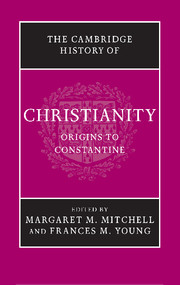Book contents
- Frontmatter
- Prelude: Jesus Christ, foundation of Christianity
- Part I The Political, Social and Religious Setting
- Part II The Jesus Movements
- Part III Community Traditions and Self-Definition
- Part IV Regional Varieties of Christianity in the First Three Centuries
- 15 From Jerusalem to the ends of the earth
- 16 Overview: the geographical spread of Christianity
- 17 Asia Minor and Achaea
- 18 Egypt
- 19 Syria and Mesopotamia
- 20 Gaul
- 21 North Africa
- 22 Rome
- Part V The Shaping of Christian Theology
- Part VI ‘Aliens’ become Citizens: towards Imperial Patronage
- Conclusion: retrospect and prospect
- Bibliographies
- Index
- Map 1. The Roman Empire in the time of Marcus Aurelius
- References
16 - Overview: the geographical spread of Christianity
from Part IV - Regional Varieties of Christianity in the First Three Centuries
Published online by Cambridge University Press: 28 March 2008
- Frontmatter
- Prelude: Jesus Christ, foundation of Christianity
- Part I The Political, Social and Religious Setting
- Part II The Jesus Movements
- Part III Community Traditions and Self-Definition
- Part IV Regional Varieties of Christianity in the First Three Centuries
- 15 From Jerusalem to the ends of the earth
- 16 Overview: the geographical spread of Christianity
- 17 Asia Minor and Achaea
- 18 Egypt
- 19 Syria and Mesopotamia
- 20 Gaul
- 21 North Africa
- 22 Rome
- Part V The Shaping of Christian Theology
- Part VI ‘Aliens’ become Citizens: towards Imperial Patronage
- Conclusion: retrospect and prospect
- Bibliographies
- Index
- Map 1. The Roman Empire in the time of Marcus Aurelius
- References
Summary
Methods, sources, and demographic judgements
The demographic study of earliest Christianity began with Adolf von Harnack’s Die Mission und Ausbreitung des Christentums. Relying on the critical analysis of literary sources, Harnack saw demographically significant Christian communities wherever there was a martyrdom narrative or clear evidence for an episcopal see. This assessment was influenced by Tertullian and Origen, who both argued that Christianity was expanding rapidly in all parts of the empire, even in remote corners like Britain. Nearly a century of research since then has clarified the issue, but these studies are still in their infancy. The first step is to look particularly at what evidence has become available since Harnack’s pioneering work.
Three specific genres of evidence lend themselves to demographic analysis: inscriptions, papyri and archaeological artefacts. As material evidence, they permit the localisation of early Christian communities at particular sites and historical moments, as long as dates can be assigned with relative precision. Inscriptions are the most useful genre, because of their wide distribution in town and countryside, and because, as demotic documents, they give expression to the social norms and theological concepts of ordinary people. The greatest part of the epigraphy by far consists of funerary inscriptions.
Keywords
- Type
- Chapter
- Information
- The Cambridge History of Christianity , pp. 302 - 313Publisher: Cambridge University PressPrint publication year: 2006
References
- 3
- Cited by



